A Theoretical Analysis of Favorable Propagation on Massive MIMO Channels with Generalized Angle Distributions
Abstract
:1. Introduction
- To the best of the authors’ knowledge, it is the first time to analyze the FP condition of the 3D MIMO channel with both horizontal and elevation domains. Moreover, we investigate whether the real channel satisfies the FP condition in this paper.
- The expectations and variances of the channel steering vector inner product are derived mathematically. Moreover, they are applied to analyzing different antenna arrays by changing the coordinates of antenna elements, such as UPA and UCA.
- We theoretically prove that the asymptotically FP condition is satisfied under generalized angle distributions, i.e., WG-TL and VM-TL. The FP condition under uniform distributions is a particular case for our results, and it underestimates the capacity gap between real channels and the channel under the FP condition.
- We analyze the FP condition under different antenna spacing in the numerical simulations. It is noted that small antenna spacing, i.e., smaller than half-wavelength, leads to large inter-user interference. The effect of the antenna array on the FP condition is studied, and suitable spacing and array types are recommended.
- The FP condition is also validated by practical measurements. It is observed that environments with larger angle spreads are more likely to satisfy the asymptotically FP condition. Moreover, users in significantly different propagation environments are more likely to have orthogonal channel vectors.
2. Preliminaries
2.1. System Model
2.2. 3D MIMO Channel Model
- is the large-scale fading.
- is the normalized power of the kth user’s cluster c.
- are the normalized complex amplitude, azimuth AOA, elevation AOA of the lth ray in the cth cluster for the kth user, respectively.
- .
- is the antenna array steering vector. And the element of is when each antenna radiation pattern is assumed to be omnidirectional. is the mth antenna element’s location vector in a Cartesian coordinate system.
2.3. Favorable Propagation and Channel Capacity
3. Asymptotically Favorable Propagation Analysis Using WG-TL and VM-TL
3.1. Asymptotically FP Analysis
3.2. Statistical Property Analysis under Generalized Angle Distributions
3.2.1. Von Mises and Truncated Laplacian Distributions
- is the constant component associated with the distribution of AOA,
- are given by
- are the functions of antenna coordinates in (17). is equal to . are the Fourier series coefficients of .
3.2.2. Wrapped Gaussian and Truncated Laplacian Distributions
- is the constant component associated with the AOAs’ distribution, and , .
- are given byand is the error function for complex argument [39].
3.2.3. Uniform Distributions
- When we make in VM be zero, we have
- When we make in WG and in TL tend to infinity and utilize the L Hospital (LH) rule, we have
3.2.4. Azimuth Angle Distributions
4. Numerical Simulations
4.1. Statistical Property Analysis
4.2. Measures of the Favorable Propagation
5. Measurement Validation
5.1. Measurement Description
5.2. Result Analysis
6. Conclusions
Author Contributions
Funding
Institutional Review Board Statement
Informed Consent Statement
Data Availability Statement
Conflicts of Interest
Appendix A. Proofs of E(ξ) and Var(ξ) under VM-TL Distributions
References
- IMT Vision-Framework and Overall Objectives of the Future Development of IMT for 2020 and Beyond; International Telecommunication Union: New York, NY, USA, 2015.
- Tataria, H.; Shafi, M.; Molish, A.F.; Dohler, M.; Sjöland, H.; Tufvesson, F. 6G wireless systems: Vision, requirements, challenges, insights, and opportunities. Proc. IEEE 2021, 109, 1166–1199. [Google Scholar] [CrossRef]
- Agbotiname, L.I.; Oluwadara, A.; Nistha, T.; Sachin, S. 6G Enabled Smart Infrastructure for Sustainable Society: Opportunities, Challenges, and Research Roadmap. Sensors 2021, 21, 1709. [Google Scholar]
- Marzetta, T.L. Noncooperative Cellular Wireless with Unlimited Numbers of Base Station Antennas. IEEE Trans. Wirel. Commun. 2010, 9, 3590–3600. [Google Scholar] [CrossRef]
- Zhang, J.; Zhang, Y.; Yu, Y.; Xu, R.; Zheng, Q.; Zhang, P. 3-D MIMO: How Much Does It Meet Our Expectations Observed From Channel Measurements? IEEE J. Select. Areas Commun. 2017, 35, 1887–1903. [Google Scholar] [CrossRef]
- Zhang, J.; Zheng, Z.; Zhang, Y.; Xi, J.; Zhao, X.; Gui, G. 3D MIMO for 5G NR: Several Observations from 32 to Massive 256 Antennas Based on Channel Measurement. IEEE Commun. Mag. 2018, 56, 62–70. [Google Scholar] [CrossRef]
- Rusek, F.; Persson, D.; Lau, B.K.; Larsson, E.G.; Marzetta, T.L.; Edfors, O.; Tufvesson, F. Scaling up MIMO: Opportunities and challenges with very large arrays. IEEE Sign. Process. Mag. 2013, 30, 40–60. [Google Scholar] [CrossRef] [Green Version]
- Borges, D.; Montezuma, P.; Dinis, R.; Beko, M. Massive MIMO Techniques for 5G and beyond opportunities and Challenges. Electronics 2021, 10, 1667. [Google Scholar] [CrossRef]
- Zhang, M.; Tan, L.; Huang, K.; You, L. On the Trade-Off between Energy Efficiency and Spectral Efficiency in RIS-Aided Multi-User MISO Downlink. Electronics 2021, 10, 1307. [Google Scholar] [CrossRef]
- Zhang, J.; Pan, C.; Pei, F.; Liu, G.; Cheng, X. Three-dimensional fading channel models: A survey of elevation angle research. IEEE Commun. Mag. 2014, 52, 218–226. [Google Scholar] [CrossRef]
- Yu, Y.; Zhang, J.; Smith, P.J.; Dmochowski, P.A. Theoretical Analysis of 3-D Channel Spatial Correlation and Capacity. IEEE Commun. Lett. 2018, 22, 420–423. [Google Scholar] [CrossRef]
- Yu, Y.; Smith, P.J.; Dmochowski, P.A.; Zhang, J.; Shafi, M. 3D vs. 2D channel models: Spatial correlation and channel capacity comparison and analysis. In Proceedings of the 2017 IEEE International Conference on Communications (ICC), Paris, France, 21–25 May 2017; pp. 1–7.
- Nam, Y.; Ng, B.L.; Sayana, K.; Li, Y.; Zhang, J.; Kim, Y.; Lee, J. Full-dimension MIMO (FD-MIMO) for next generation cellular technology. IEEE Commun. Mag. 2013, 51, 172–179. [Google Scholar] [CrossRef]
- Pizzo, A.; Marzetta, T.L.; Sanguinetti, L. Spatially-stationary model for holographic MIMO small-scale fading. IEEE J. Select. Areas Commun. 2020, 38, 1964–1979. [Google Scholar] [CrossRef]
- Pizzo, A.; Sanguinetti, L.; Marzetta, T.L. Fourier Plane-Wave Series Expansion for Holographic MIMO Communications. IEEE Trans. Wirel. Commun. 2022, 1. [Google Scholar] [CrossRef]
- Sun, Y.; Tian, L.; Zhang, J.; Wu, L.; Zhang, P. On asymptotic favorable propagation condition for massive MIMO with co-located user terminals. In Proceedings of the 2014 International Symposium on Wireless Personal Multimedia Communications (WPMC), Sydney, Austrlia, 7–10 September 2014; pp. 706–711. [Google Scholar]
- Zhang, J.; Zhang, J.; Tian, L.; Xu, R.; Zhang, Z. Favorable Propagation with Practical Angle Distributions for mm Wave Massive MIMO Systems. In Proceedings of the 2019 IEEE International Conference on Communications Workshops (ICC Workshops), Shanghai, China, 20–24 May 2019; pp. 1–6. [Google Scholar]
- Ngo, H.Q.; Larsson, E.G.; Marzetta, T.L. Aspects of favorable propagation in Massive MIMO. In Proceedings of the 2014 22nd European Signal Processing Conference (EUSIPCO), Lisbon, Portugal, 1–5 September 2014; pp. 76–80. [Google Scholar]
- Papazafeiropoulos, A.; PaKourtessis, P.; Renzo, M.D.; Chatzinotas, S.; Senior, J.M. Performance Analysis of Cell-Free Massive MIMO Systems: A Stochastic Geometry Approach. IEEE Trans. Veh. Technol. 2020, 69, 3523–3537. [Google Scholar] [CrossRef] [Green Version]
- Chien, T.V.; Ngo, H.Q.; Chatzinotas, S.; Ottersten, B. Reconfigurable Intelligent Surface-Assisted Massive MIMO: Favorable propagation, channel hardening, and rank deficiency. IEEE Sign. Process. Mag. 2022, 39, 97–104. [Google Scholar] [CrossRef]
- Wu, X.; Beaulieu, N.C.; Liu, D. On Favorable Propagation in Massive MIMO Systems and Different Antenna Configurations. IEEE Access 2017, 5, 5578–5593. [Google Scholar] [CrossRef]
- Cai, W.; Wang, P.; Li, Y.; Zhang, Y.; Pan, P. Asymptotic Capacity Analysis for Sparse Multipath Multiple-Input Multiple-Output Channels. IEEE Commun. Lett. 2015, 19, 2262–2265. [Google Scholar] [CrossRef]
- Kebede, T.; Wondie, Y.; Steinbrunn, J. Channel Estimation and Beamforming Techniques for mm Wave-Massive MIMO: Recent Trends, Challenges and Open Issues. In Proceedings of the 2021 International Symposium on Networks, Computers and Communications (ISNCC), Abu Dhabi, Dubai, 1–3 June 2021. [Google Scholar]
- Shafi, M.; Zhang, J.; Tataria, H.; Molisch, A.F.; Sun, S.; Rappaport, T.S.; Tufvesson, F.; Wu, S.; Kitao, K. Microwave vs. Millimeter-Wave Propagation Channels: Key Differences and Impact on 5G Cellular Systems. IEEE Commun. Mag. 2018, 56, 14–20. [Google Scholar] [CrossRef]
- Yoo, J.; Sung, W.; Kim, I. 2D-OPC Subarray Structure for Efficient Hybrid Beamforming over Sparse mmWave Channels. Int. J. Antennas Propag. 2021, 2021, 6680566. [Google Scholar] [CrossRef]
- Pratschner, S.; Blazek, T.; Groll, H.; Caban, S.; Schwarz, S.; Rupp, M. Measured User Correlation in Outdoor-to-Indoor Massive MIMO Scenarios. IEEE Access 2020, 8, 178269–178282. [Google Scholar] [CrossRef]
- Gao, X.; Edfors, O.; Rusek, F.; Tufvesson, F. Massive MIMO Performance Evaluation Based on Measured Propagation Data. IEEE Trans. Wirel. Commun. 2015, 14, 3899–3911. [Google Scholar] [CrossRef] [Green Version]
- Guevara, A.P.; Bast, S.D.; Pollin, S. Massive MIMO: A Measurement-Based Analysis of MR Power Distribution. In Proceedings of the 2020 IEEE Global Communications Conference, Taipei, Taiwan, 7–11 December 2020. [Google Scholar]
- I-METRA D2: Channel Characterisation; Information Society Technologies: New York, NY, USA, 2012.
- Ampoma, A.E.; Wen, G.; Zhang, H.; Huang, Y.; Gyasi, O.K.; Tebe, P.I. 3D correlation function of a uniform circular array using maximum power in the direction of arrival. In Proceedings of the 2017 Progress in Electromagnetics Research Symposium-Fall (PIERS-FALL), Singapore, 19–22 November 2017; pp. 2996–3003. [Google Scholar]
- Nadeem, Q.; Kammoun, A.; Debbah, M.; Alouini, M. A Generalized Spatial Correlation Model for 3D MIMO Channels Based on the Fourier Coefficients of Power Spectrums. IEEE Trans. Sign. Process. 2015, 63, 3671–3686. [Google Scholar] [CrossRef] [Green Version]
- Ampoma, A.E.; Wen, G.; Huang, Y.; Gyasi, K.O.; Tebe, P.I.; Ntiamoah-Sarpong, K. Spatial Correlation Models of Large-Scale Antenna Topologies Using Maximum Power of Offset Distribution and its Application. IEEE Access 2018, 6, 36295–36304. [Google Scholar] [CrossRef]
- Queiroz, W.J.; Madeiro, F.; Lopes, W.T.A.; Alencar, M.S. Spatial Correlation for DoA Characterization Using Von Mises, Cosine, and Gaussian Distributions. Int. J. Antennas Propag. 2011, 2011, 540275. [Google Scholar] [CrossRef]
- Study on Channel Model for Frequency from 0.5 to 100 GHz (Release 14). 2017. Available online: http://www.3gpp.org/ (accessed on 30 May 2022).
- Guidelines for Evaluation of Radio Interface Technologies for IMT-2020; Information Society Technologies: New York, NY, USA, 2017.
- Li, Y.; Zhang, J.; He, R.; Tian, L.; Wei, H. Hybrid DE-EM Algorithm for Gaussian Mixture Model-Based Wireless Channel Multipath Clustering. Int. J. Antennas Propag. 2019, 2019, 4639612. [Google Scholar] [CrossRef]
- Temiz, M.; Alsusa, E.; Danoon, L.; Zhang, Y. On the Impact of Antenna Array Geometry on Indoor Wideband Massive MIMO Networks. IEEE Trans. Antennas Propag. 2020, 69, 406–416. [Google Scholar] [CrossRef]
- Lindgren, B. Statistical Theory; Routledge: London, UK, 2017. [Google Scholar]
- Abramowitz, M.; Stegun, I.A. Handbook of Mathematical Functions with Formulas, Graphs and Mathematical Tables; Dover: New York, NY, USA, 1970. [Google Scholar]
- Tse, D.; Viswanath, P. Fundamentals of Wireless Communications; Cambridge University Press: Cambridge, UK, 2005. [Google Scholar]
- Pizzo, A.; Marzetta, T.L.; Sanguinetti, L. Degrees of freedom of holographic MIMO channels. In Proceedings of the 2020 IEEE 21st International Workshop on Signal Processing Advances in Wireless Communications (SPAWC), Online, 26–29 May 2020. [Google Scholar]
- Neil, C.T.; Shafi, M.; Smith, P.J.; Dmochowski, P.A.; Zhang, J. Impact of Microwave and mmWave Channel Models on 5G Systems Performance. IEEE Trans. Antennas Propag. 2017, 65, 6505–6520. [Google Scholar] [CrossRef]
- Gradshteyn, I.S.; Ryzhik, I.M. Table of Integrals, Series, and Products, 7th ed.; Academic Press: Cambridge, MA, USA, 2014. [Google Scholar]
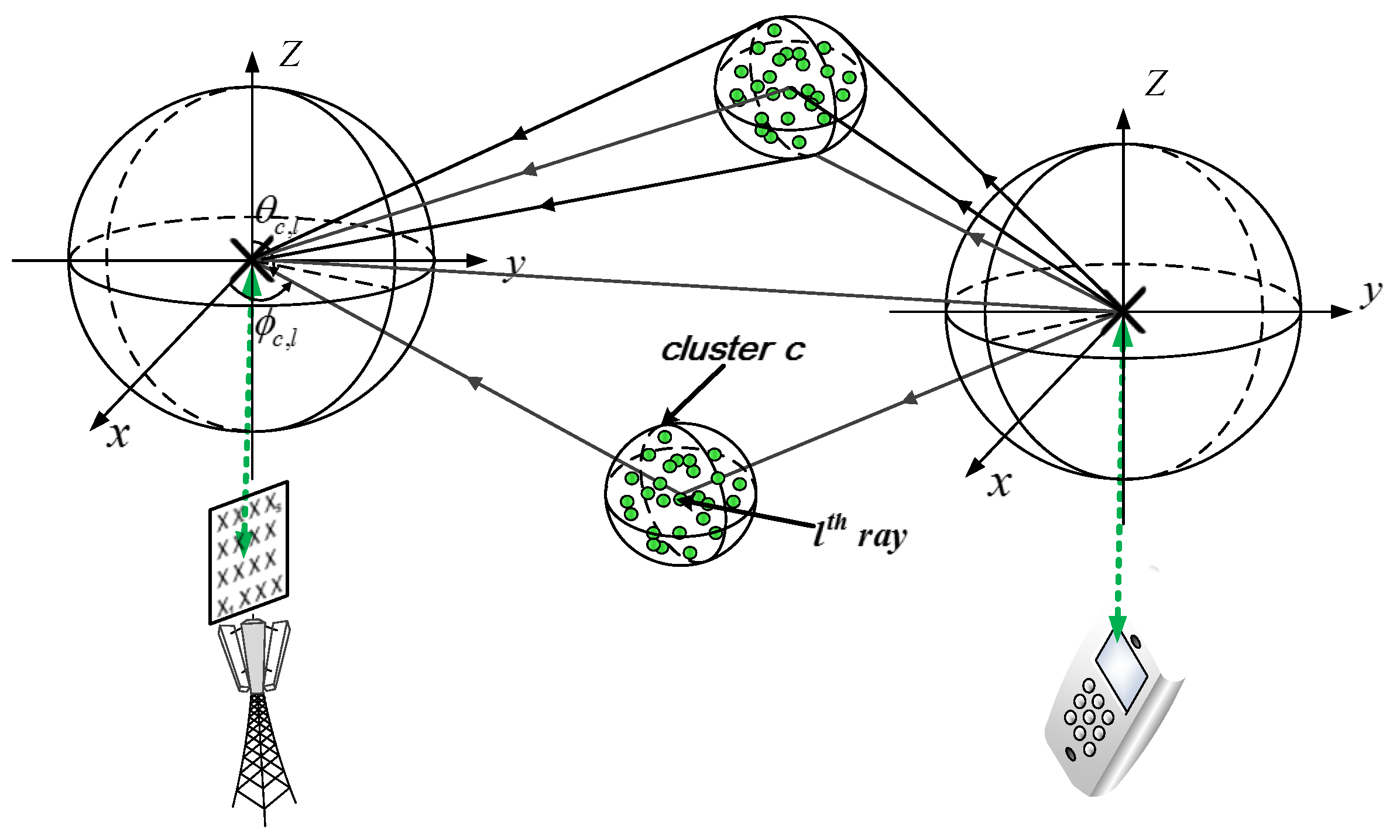
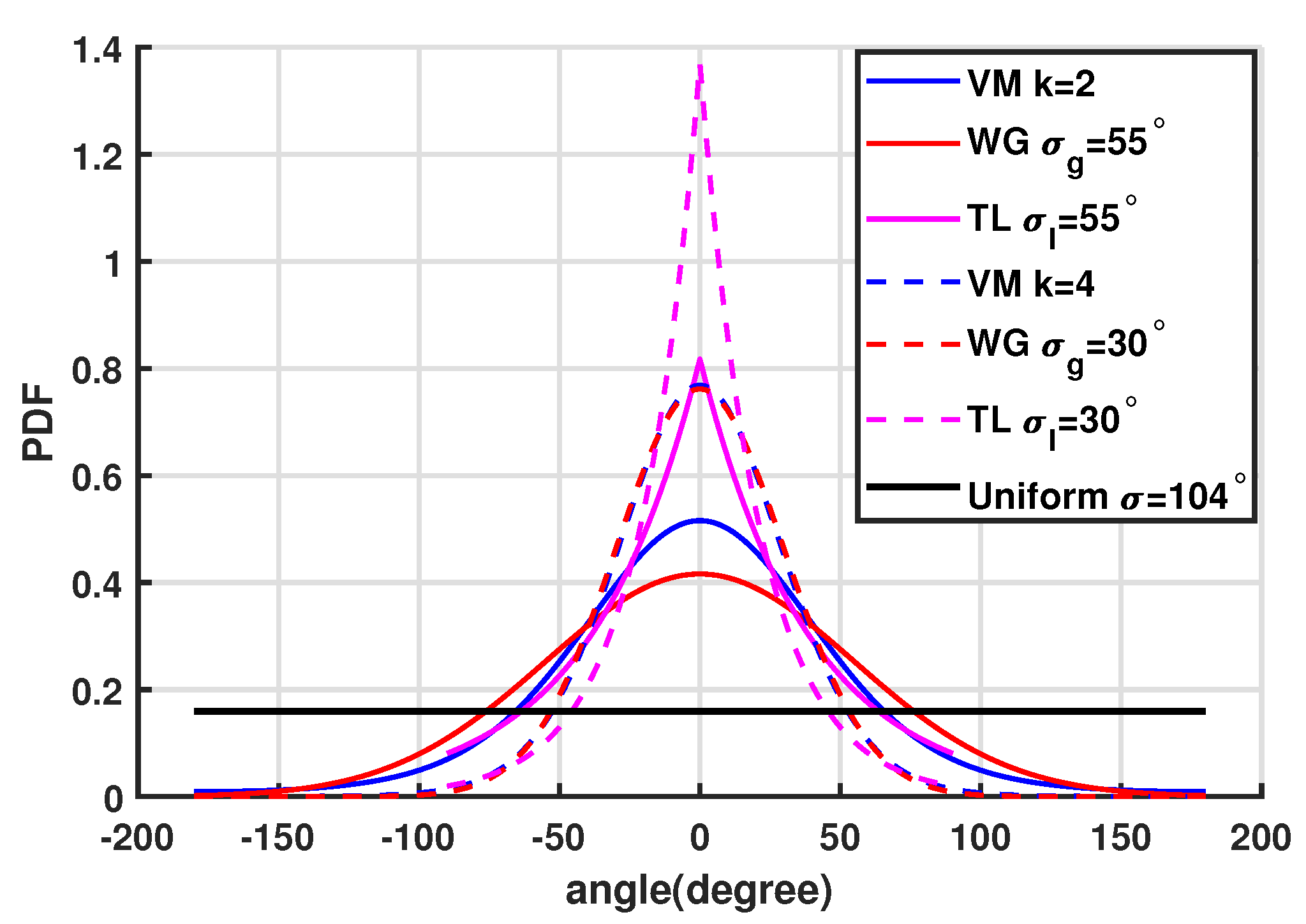
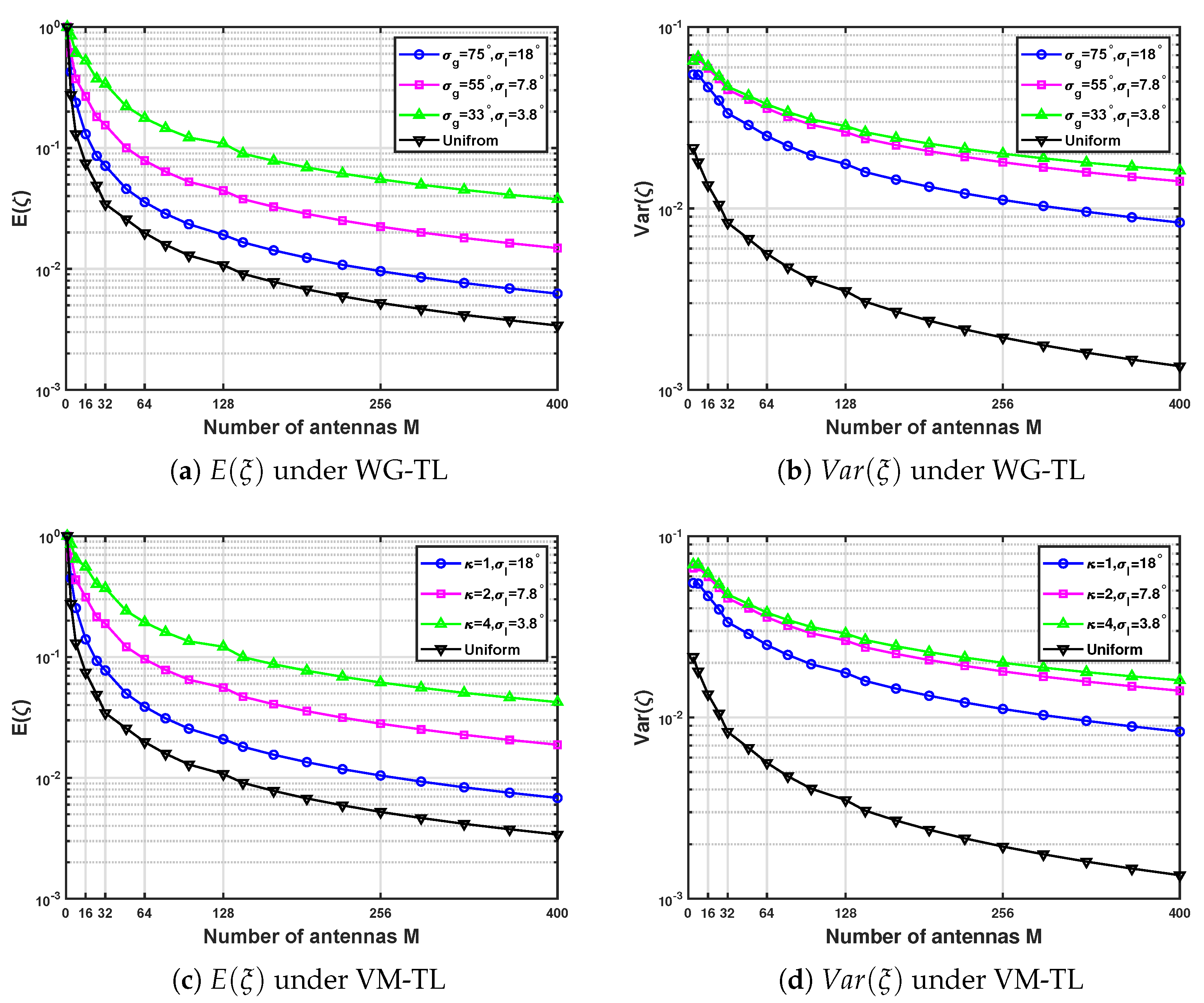
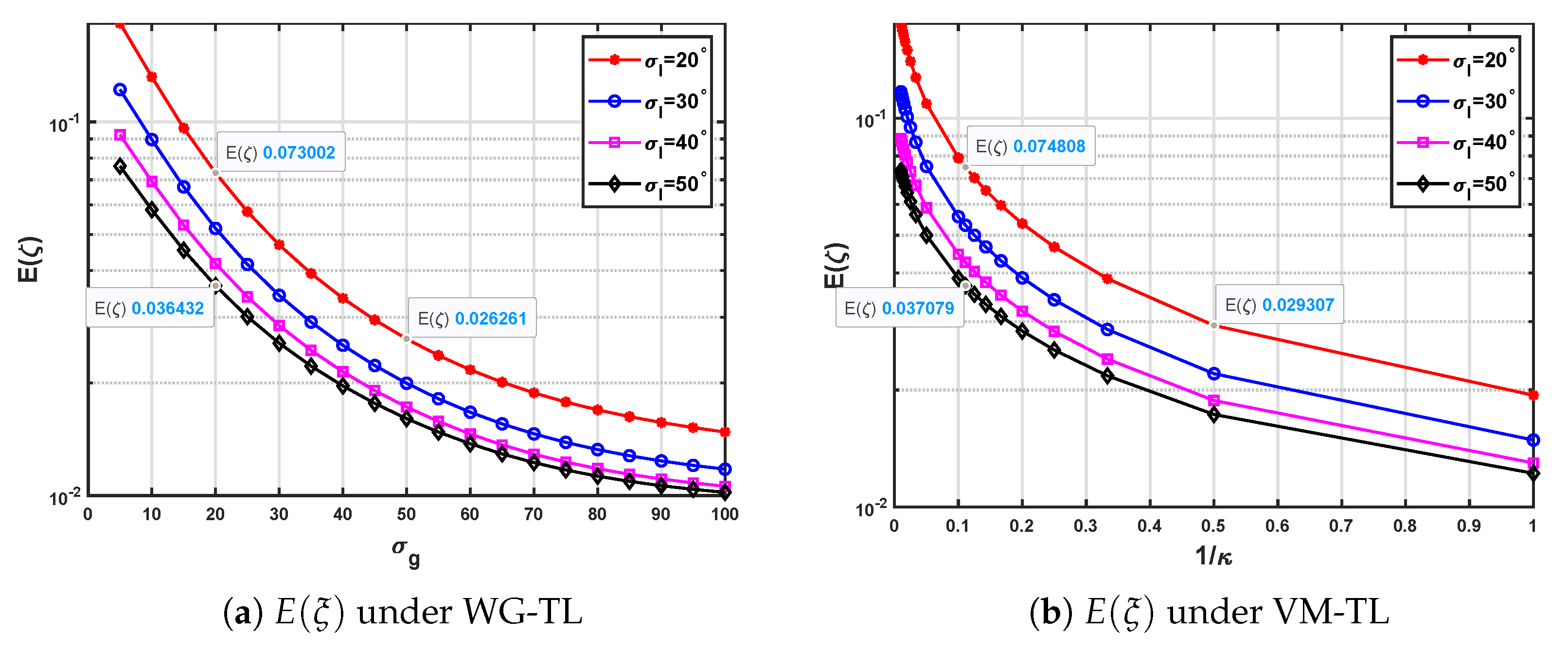
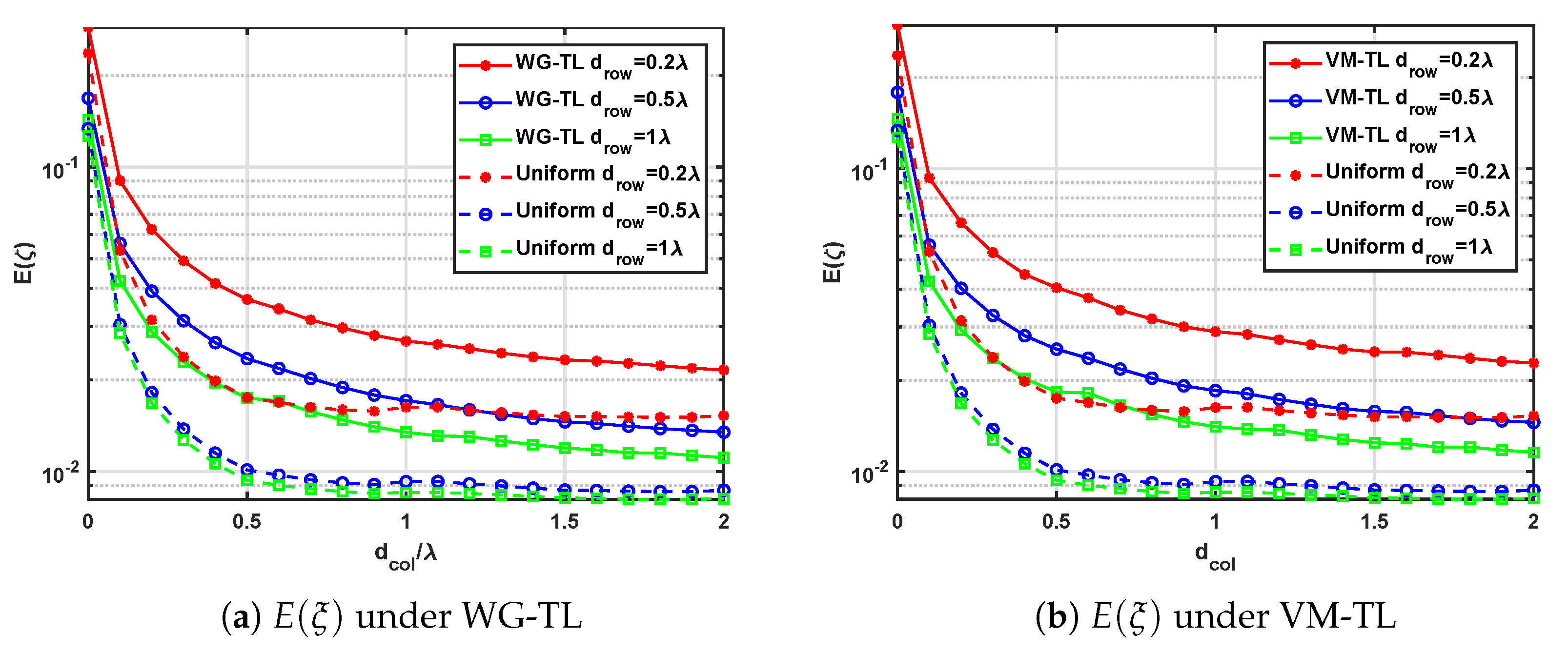
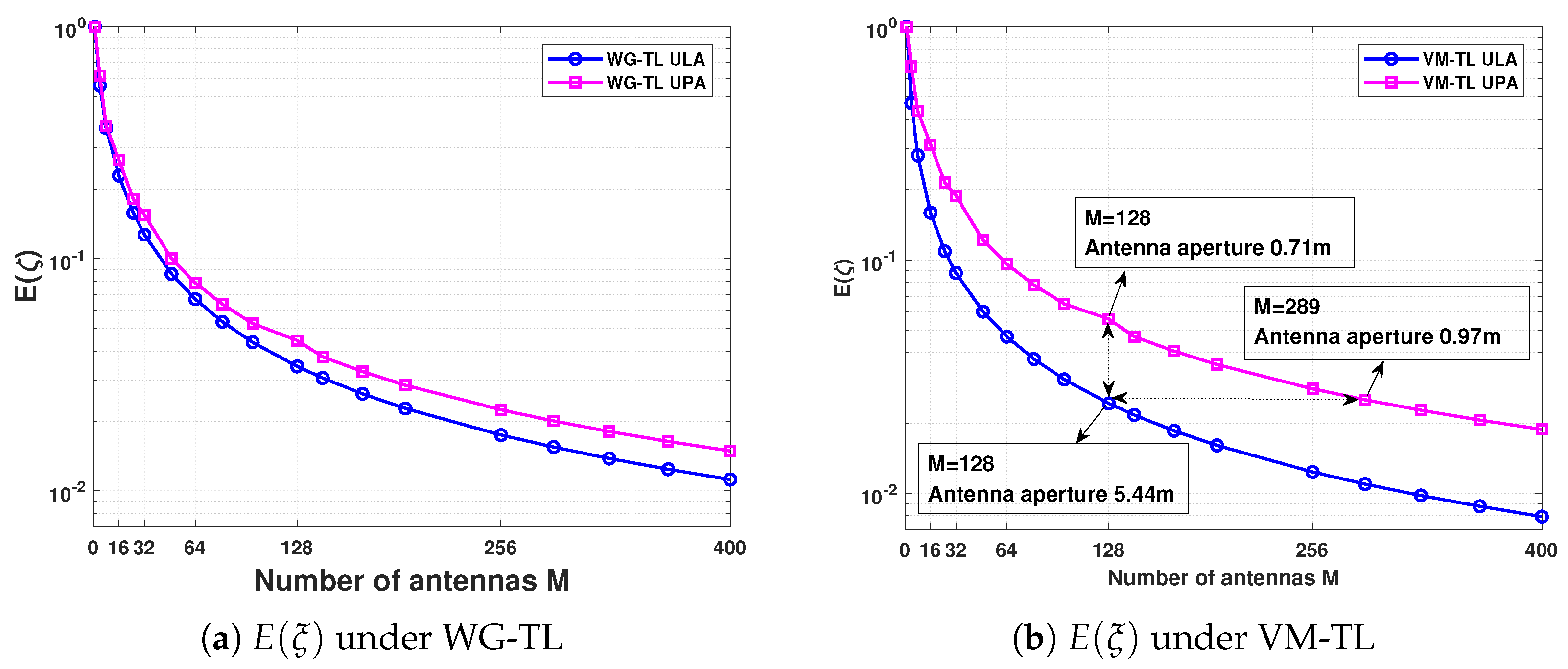
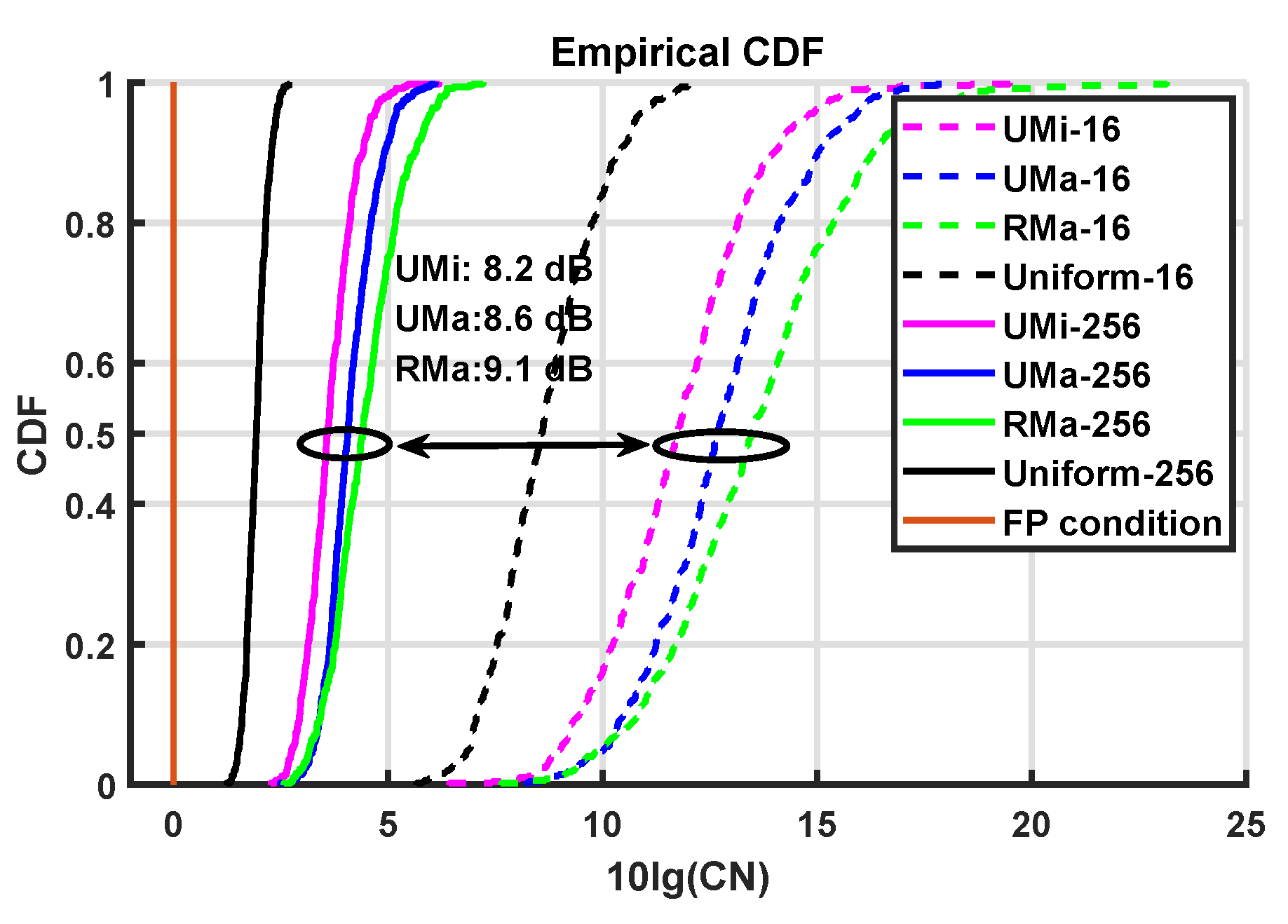
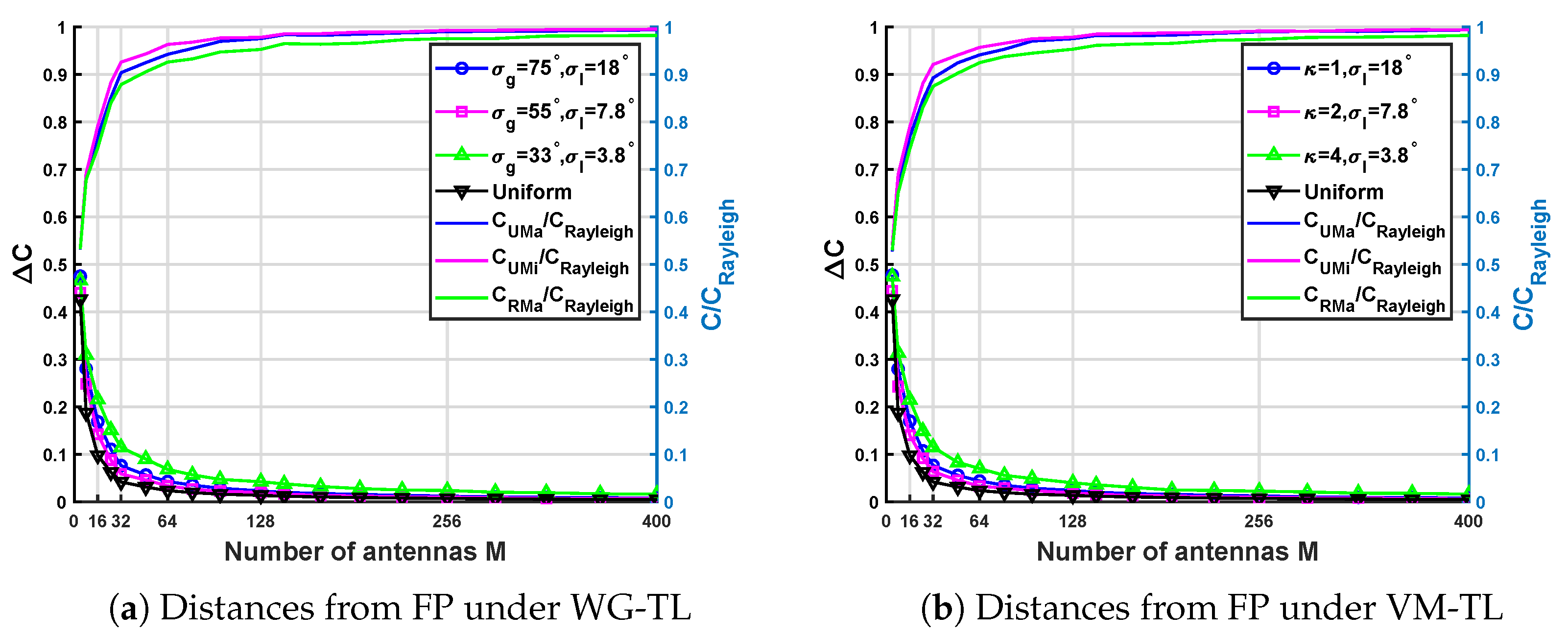
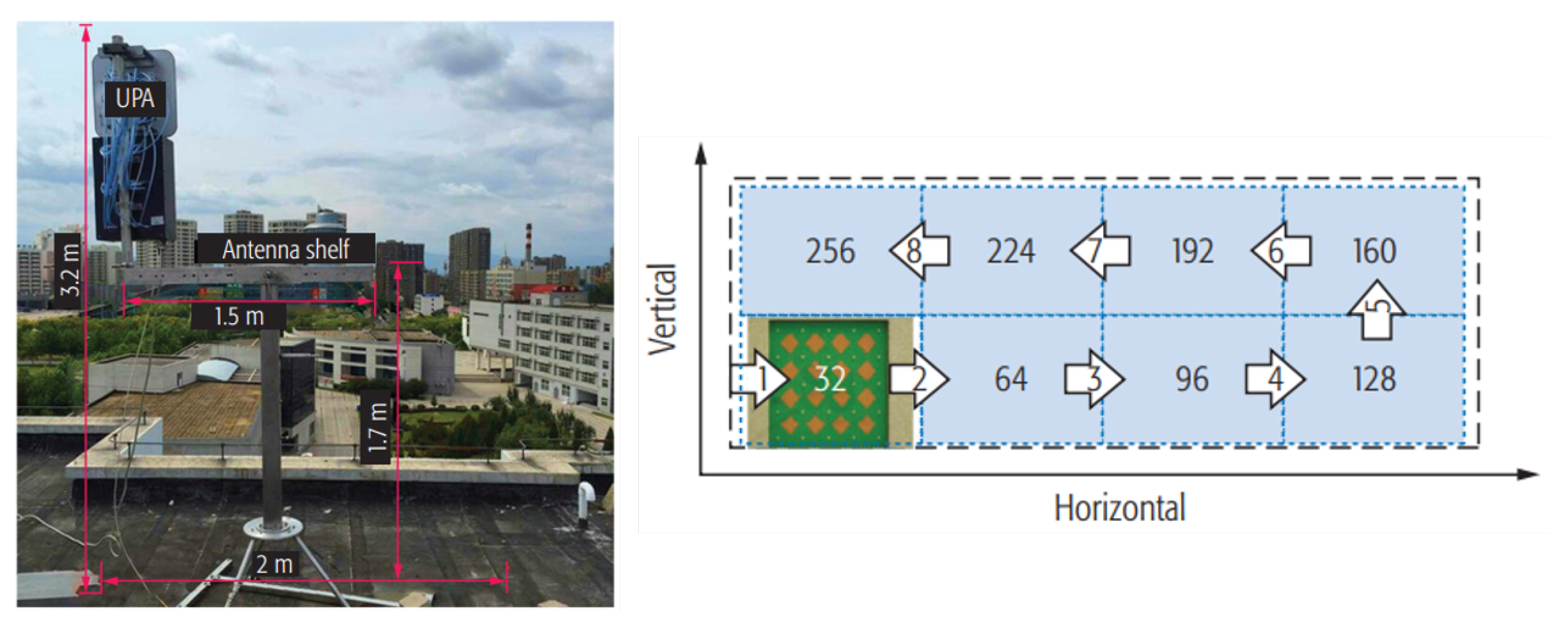
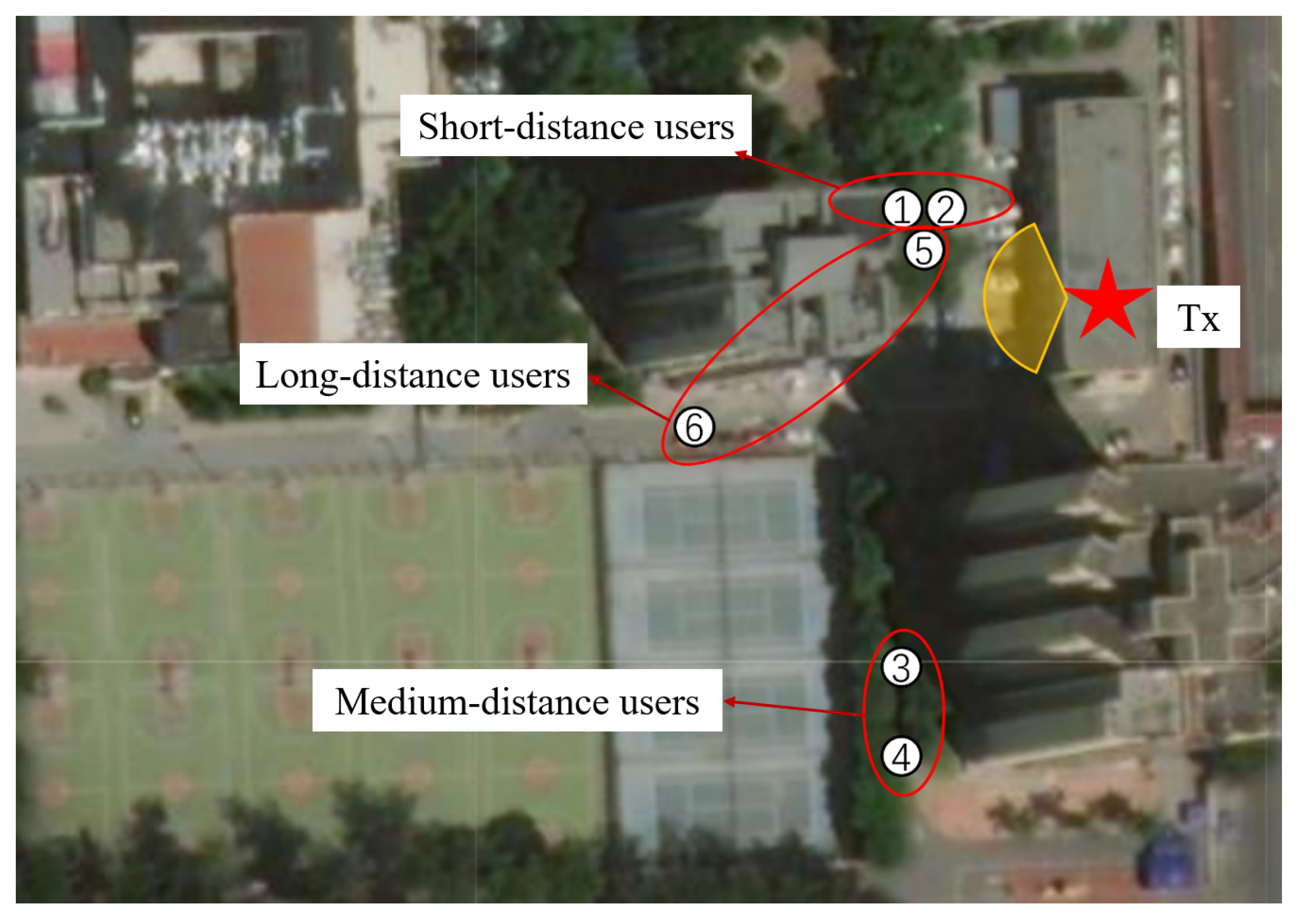
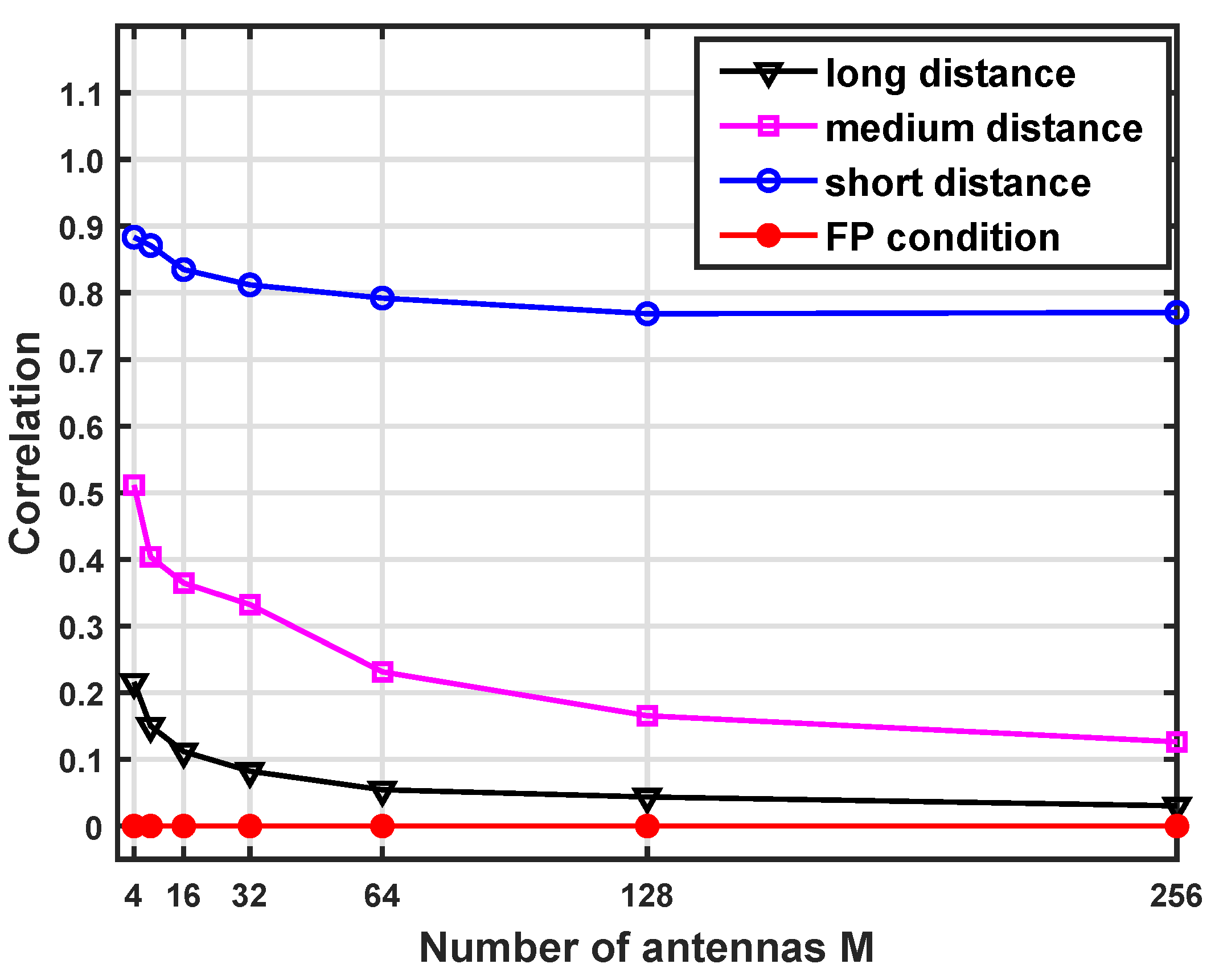
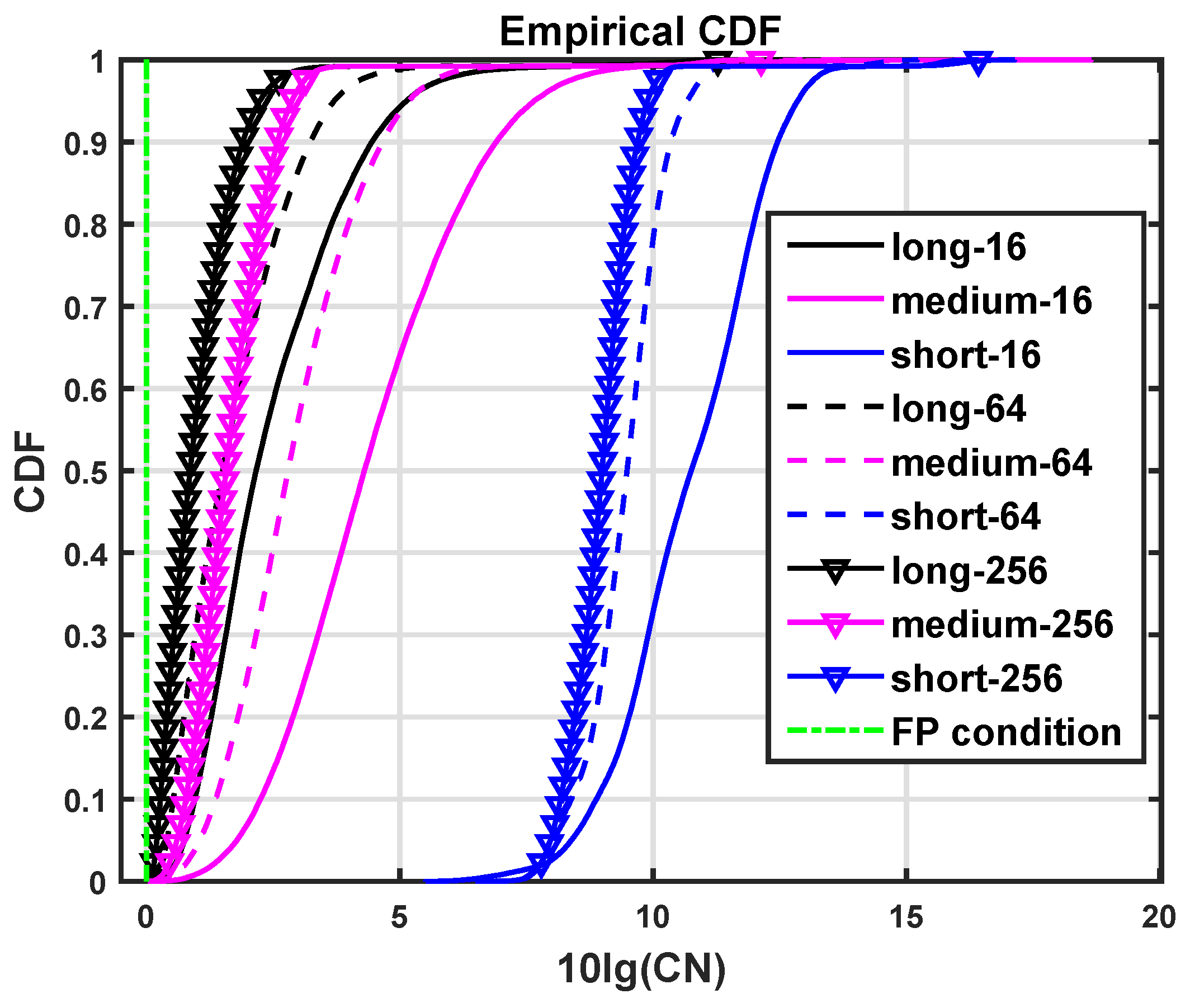
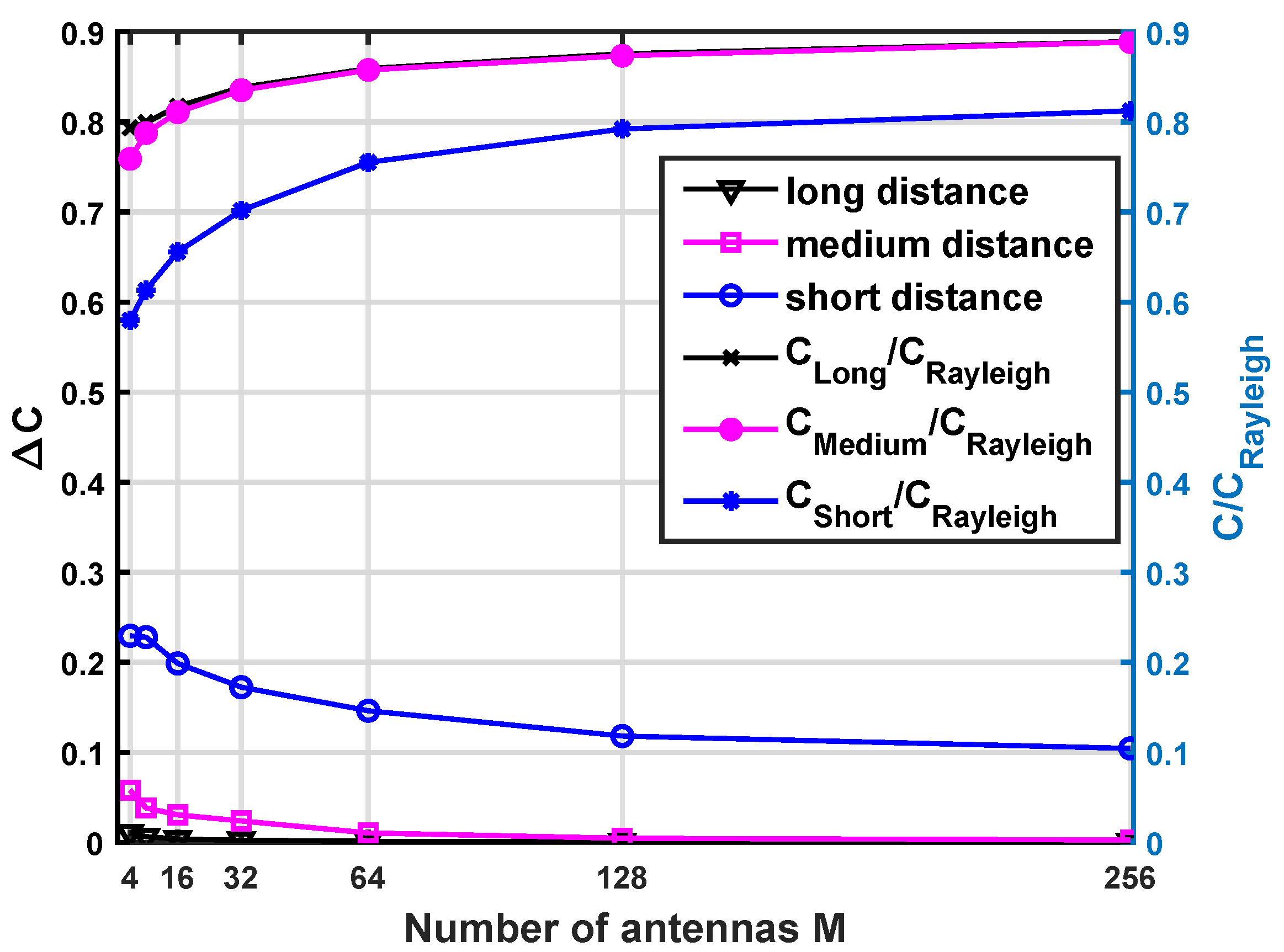
| Distribution | Domain | |
|---|---|---|
| Wrapped Gaussian [34] | ||
| Von Mises [31] | ||
| Truncated Laplacian [34] | ||
| Uniform [21] | ||
| Scenarios (NLOS) | UMa | UMi | RMa |
|---|---|---|---|
| Center frequency | 3.5 GHz | ||
| Number of clusters | 20 | 19 | 10 |
| Number of rays per cluster | 20 | 20 | 20 |
| Concentration factor | 1 | 2 | 4 |
| Inter-cluster azimuth angle spread | 75 | 55 | 33 |
| Inter-cluster elevation angle spread | 18 | 7.8 | 3.8 |
| Intra-cluster azimuth angle spread | 15 | 22 | 3 |
| Intra-cluster elevation angle spread | 7 | 7 | 3 |
| Type | Element Number | |||||||||||||||||
|---|---|---|---|---|---|---|---|---|---|---|---|---|---|---|---|---|---|---|
| Total | 4 | 8 | 16 | 25 | 32 | 49 | 64 | 81 | 100 | 128 | 144 | 169 | 196 | 256 | 289 | 324 | 361 | 400 |
| Horizontal | 2 | 4 | 4 | 5 | 8 | 7 | 8 | 9 | 10 | 16 | 12 | 13 | 14 | 16 | 17 | 18 | 19 | 20 |
| Vertical | 2 | 2 | 4 | 5 | 4 | 7 | 8 | 9 | 10 | 8 | 12 | 13 | 14 | 16 | 17 | 18 | 19 | 20 |
| Case | UMi-16 | UMa-16 | RMa-16 | UMi-256 | UMa-256 | RMa-256 |
|---|---|---|---|---|---|---|
| 0.2606 | 0.3101 | 0.3794 | 0.0775 | 0.0966 | 0.1034 |
Publisher’s Note: MDPI stays neutral with regard to jurisdictional claims in published maps and institutional affiliations. |
© 2022 by the authors. Licensee MDPI, Basel, Switzerland. This article is an open access article distributed under the terms and conditions of the Creative Commons Attribution (CC BY) license (https://creativecommons.org/licenses/by/4.0/).
Share and Cite
Zhang, Y.; Zhang, J.; Zhang, J.; Liu, G.; Zhang, Y.; Yao, Y. A Theoretical Analysis of Favorable Propagation on Massive MIMO Channels with Generalized Angle Distributions. Electronics 2022, 11, 2150. https://doi.org/10.3390/electronics11142150
Zhang Y, Zhang J, Zhang J, Liu G, Zhang Y, Yao Y. A Theoretical Analysis of Favorable Propagation on Massive MIMO Channels with Generalized Angle Distributions. Electronics. 2022; 11(14):2150. https://doi.org/10.3390/electronics11142150
Chicago/Turabian StyleZhang, Yuxiang, Jianhua Zhang, Jian Zhang, Guangyi Liu, Yuan Zhang, and Yuan Yao. 2022. "A Theoretical Analysis of Favorable Propagation on Massive MIMO Channels with Generalized Angle Distributions" Electronics 11, no. 14: 2150. https://doi.org/10.3390/electronics11142150
APA StyleZhang, Y., Zhang, J., Zhang, J., Liu, G., Zhang, Y., & Yao, Y. (2022). A Theoretical Analysis of Favorable Propagation on Massive MIMO Channels with Generalized Angle Distributions. Electronics, 11(14), 2150. https://doi.org/10.3390/electronics11142150








